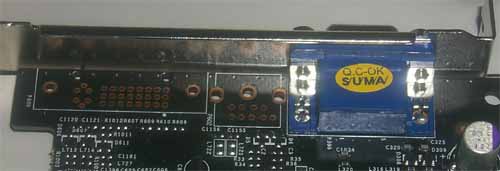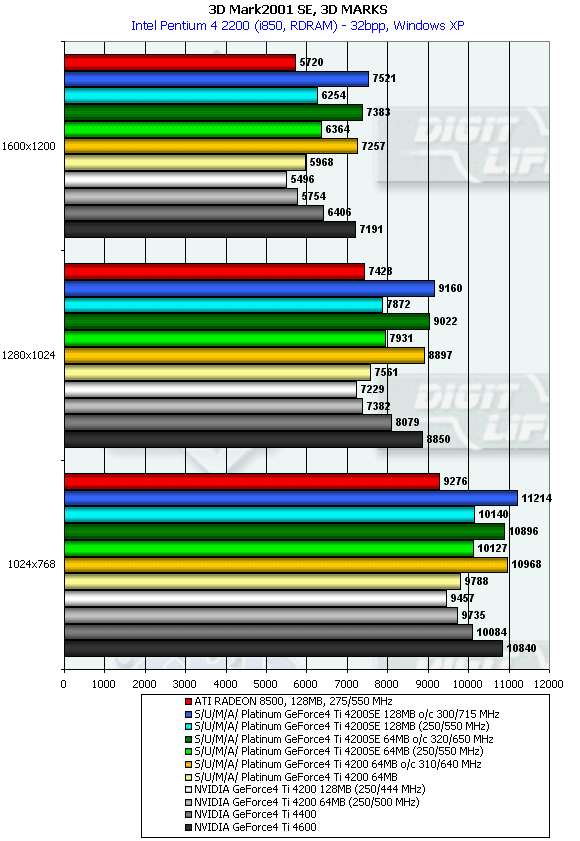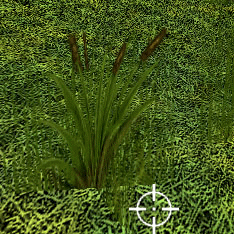 |
||
|
||
| ||
 Contents
A few weeks ago we studied SUMA video cards based on the latest NVIDIA's solutions. At that time we examined cards coming with the most powerful graphics accelerators - GeForce4 Ti 4400 and 4600. What do the products from SUMA Electron (former SuperMicro Systems) (SUMA) differ from other 3D accelerators of the same class? First of all, they use a non-standard approach for production of video cards. They use either more expensive PCBs for cheap products, or faster memory than recommended (by NVIDIA), or a combination of these approaches. If the SUMA products use one of these approaches, their names get SE suffix. So, today we will take a look at three video cards, two of which have such suffix. As usual, let me show you the list of reviews of the GeForce4 Ti cards already published on our site. Theoretical materials and reviews of video cards which concern functional properties of the NVIDIA GeForce4 Ti GPU
As you might know, SUMA produces almost the whole range of video cards based on NVIDIA's GPUs. When the Ti 4200 just appeared on the market, the Korean company was among the first to release the whole line of video accelerators based on this chipset. Just remember that the GeForce4 Ti 4200 differs from the senior models only in frequencies; besides, there is a 64 MBytes model. CardsAll cards have an AGP x2/x4 interface, DDR SDRAM located in 8 chips on both sides of the PCB.
Both 64 MBytes cards use a PCB which is identical to the reference one. What are the differences between the SE and usual revision of the cards? They differ not only in the memory, but also in DVI and TV-out of the SE, which means dual-head support. Remember that the SUMA Platinum GeForce4 Ti 4200 64 MBytes has only one VGA connector! But there is one more revision of this card which has a TV-out.  In all other respects, the cards are identical. Even the heatsinks are used only on the right sides.  By the way, the heatsinks come from Ti 4400/4600 cards (single, glued to the BGA chips). The same are used on the SUMA Platinum GeForce4 Ti 4200 SE 128 MBytes:  All three cards have identical coolers on the GPUs. The heatsink contains a fan of the turbine type.  In the center you can see the SUMA's logo with an eagle.  Under the cooler you can see the GPU:  The revision and marking of the chip is the same for all three cards. It should be noted that SUMA produces cards on the Ti 4200 with 128 MBytes of memory which use a PCB from more expensive Ti 4600, as well as with the reference design of this chipset. Today we have a 128 MBytes card with the PCB from a more expensive Ti 4600. Of course, it influences the price making it quite high, but I must note that the company keeps on reducing them; besides, the 128 MBytes card comes with 3.3ns memory modules which mean a good overclocking potential. Thus, you can buy a Ti 4600 card at $220. The TV-out comes with only two cards: both with the SE suffix (but soon we will get a non-SE revision with the TV-out). On the whole, the design of the cards is typical of SUMA, all PCBs are black with silvery words. And now let's look at what's inside the packages.
All cards ship in retail packages. Overclocking
The overclocking results are excellent!!! Almost all cards have reached the level of Ti 4600, and the two even outpace it. Note:
 Test system and driversTestbed:
The test system was coupled with ViewSonic P810 (21") and ViewSonic P817 (21") monitors. In the tests we used NVIDIA's drivers of v29.20. VSync was off, S3TC was off. For the comparative analyses we used the following cards:
We have chosen the RADEON 8500 card with 128 MBytes memory as the most expensive on this graphics processor. Its price is much higher than that of the most expensive Ti 4200 based card from SUMA. Test resultsBefore we start examining 2D quality I should say that there is no a complete technique of objective estimation of this parameter because:
Of course, we do our best to improve the situation, but at the moment I can't promise anything. As for the tested samples, together with the ViewSonic P817 monitor and BNC Bargo cable they showed very good quality at the following frequencies and resolutions: 1600x1200x100 Hz, 1600x1200x85 Hz, 1280x1024x100 Hz. For estimation of 3D performance we used:
The tests were carried out in 32-bit color mode. With the OpenGL games we are also estimating operation of anisotropic filtering, i.e. how it affects the speed. 3D Mark2001 SEGame1 Low Details As you can see, the SUMA SE cards perform better than the reference one everywhere. All cards fight excellently against the ATI's solution, though the latter is dearer. Thanks to the nice overclocking capabilities the 64 MBytes cards were able to catch up with the 128 MBytes card based on the Ti 4600! Game2 Low Details The situation is similar to the previous test: the performance of the new models is excellent, especially when they are overclocked. Besides, they still outedge the ATI RADEON 8500 128 MBytes card. Remember the price difference. Game3 Low Details This test is more difficult for the SUMA's cards, but the performance levels of the 64 MBytes cards from the Korean company and 128 MBytes RADEON 8500 are equal (they cost $160 and $250-270, respectively). Game4 This test is best for the RADEON 8500, that is why only the Ti 4600 can stand against it. 3D MARKS Here the situation reminds me of the Game1; the SUMA SE cards easily outperform the reference one, as well as the expensive ATI's solution. Return to Castle Wolfenstein The SUMA cards perform nicely without anisotropy and falls behind with the latter enabled. But we will soon examine quality of realization of this function of ATI and NVIDIA. We will also analyze performance with the new drivers from NVIDIA and where the performance gets better with anisotropy enabled. Serious Sam: The Second Encounter The advantage of the RADEON 8500 is less now when the anisotropy is enabled (although the Grand Cathedral almost lacks for surfaces uneven or unparallel to the vertical and horizontal lines). Note that there are a lot of places in this game where ATI's anisotropy doesn't work or works selectively. Just look how the anisotropy of the RADEON 8500 disappears as the distance from the viewer grows (below is the animated GIF):  ConclusionLast week at Computex'2002 one of the NVIDIA's marketers said NVIDIA had complete anisotropy, and ATI offered just a crippled one - only 10% of surfaces were processed. But this is incorrect that anisotropy is used only on 10% of surfaces. Well, some surfaces are really omitted, but not 90%. There are a lot of games with open scenes, smoothly changing surfaces etc. The screenshot above proves it. In our next 3Digest we will update the anisotropic filtering section. As far as the SUMA cards are concerned I must say that the 64 MBytes models on the Ti 4200 from this company are a very good purchase for today, especially the SE revision. A user will get higher performance, as well as excellent quality of the cards. Although the 128 MBytes card might seem quite expensive, you must take into account that it is meant for overclockers who will be able to get a Ti 4600 at a low price. At the moment of writing this article we were informed that SUMA had released a 128 MBytes card based on the reference design and carrying VIVO. Given to the tendency of price reduction I think the card will be available at less than $190-200. Remember that the non-SE 64 MBytes card doesn't have a second monitor output! That is why when buying a card examine it carefully (the plastic boxes are transparent and they have stickers indicating functional features). For more complete characteristics of video cards of this and other classes see our 3Digest. Highs:
Lows:
Write a comment below. No registration needed!
|
Platform · Video · Multimedia · Mobile · Other || About us & Privacy policy · Twitter · Facebook Copyright © Byrds Research & Publishing, Ltd., 1997–2011. All rights reserved. | |||||||||||||||||||||||||||||||||||||||||||||||||||||||||||||||||||||||